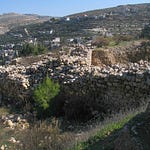The relationship between parents and their children is complex. We see examples of children with similar characteristics to their parents, closely following in their footsteps and continuing their efforts and legacies. We also see examples of children paving their own path, sometimes appearing to move in an opposite direction from their family.
Yaakov and Eisav are opposing characters. One is a conquerer, a hunter and a man of the field. The other is an intellectual, a man of integrity and perfection, who dwells in houses of study. Judaism recognizes the contributions of nature and nurture in the formation of the human personality.
בראשית כה:כז
וַֽיִּגְדְּלוּ֙ הַנְּעָרִ֔ים וַיְהִ֣י עֵשָׂ֗ו אִ֛ישׁ יֹדֵ֥עַ צַ֖יִד אִ֣ישׁ שָׂדֶ֑ה וְיַעֲקֹב֙ אִ֣ישׁ תָּ֔ם יֹשֵׁ֖ב אֹהָלִֽים
Bereisheet 25:27
The boys grew up. Esav was a man skilled in hunting, a man of the field, while Yaakov was a man of integrity, a dweller in tents.
רש"י בראשית כה:כז
ויגדלו הנערים ויהי עשו: כל זמן שהיו קטנים לא היו נכרים במעשיהם ואין אדם מדקדק בהם מה טיבם, כיון שנעשו בני שלש עשרה שנה זה פירש לבתי מדרשות וזה פירש לעבודה זרה:
Rashi Bereisheet 25:27
And the youths grew up, and Esau was: As long as they were small, they were not recognizable through their deeds, and no one scrutinized them to determine their characters. As soon as they became thirteen years old, this one parted to the houses of study, and that one parted to idol worship. — [From Gen. Rabbah 63:10; Tanchuma, Ki Theze 4]
Interestingly, Rashi asserts that the difference in character between Yaakov and Eisav was not readily apparent, but would have been noticeable had it been examined more closely.
Rashi’s approach is based in the midrash:
מדרש רבה – בראשית סג:י
וַיִּגְדְּלוּ הַנְּעָרִים (בראשית כה, כז), רַבִּי לֵוִי אָמַר מָשָׁל לַהֲדַס וְעִצְבוֹנִית שֶׁהָיוּ גְּדֵלִים זֶה עַל גַּבֵּי זֶה, וְכֵיוָן שֶׁהִגְדִּילוּ וְהִפְרִיחוּ זֶה נוֹתֵן רֵיחוֹ וְזֶה חוֹחוֹ, כָּךְ כָּל י"ג שָׁנָה שְׁנֵיהֶם הוֹלְכִים לְבֵית הַסֵּפֶר וּשְׁנֵיהֶם בָּאִים מִבֵּית הַסֵּפֶר, לְאַחַר י"ג שָׁנָה זֶה הָיָה הוֹלֵךְ לְבָתֵּי מִדְרָשׁוֹת וְזֶה הָיָה הוֹלֵךְ לְבָתֵּי עֲבוֹדַת כּוֹכָבִים. אָמַר רַבִּי אֶלְעָזָר צָרִיךְ אָדָם לְהִטָּפֵל בִּבְנוֹ עַד י"ג שָׁנָה, מִיכָּן וָאֵילָךְ צָרִיךְ שֶׁיֹּאמַר בָּרוּךְ שֶׁפְּטָרַנִּי מֵעָנְשׁוֹ שֶׁל זֶה.
Midrash Rabbah - Bereistet 63:10
And the youths grew up" (Bereishit 25:27). Rabbi Levi made an analogy to a myrtle and wild rosebush which grew next to each other; when they had grown, one gave forth scent and the other thorns. So too with these, for thirteen years they both went to school (beit hasefer) and came back from school, but after thirteen years this one went to study-houses (batei midrashot) and this one went to idolatrous temples (batei avodat kochavim). Rabbi Elazar said, until thirteen years a person needs to take care of their children - from this age onwards, they need to say "Blessed is the one who has exempted me from the punishment of this one."
The analogy is that these two plant species grow alongside one another at first, but over time their difference in nature becomes apparent to all. The midrash also implies that Yaakov and Eisav received a uniform education, “they both went to school and came back from school”. Rav Hirsch builds on these elements in explaining the evolution of their respective personalities:
Rav Samson Raphael Hirsch - Commentary on Bereshis 25:27
An observation made by our Sages indicates that the sharp contrast between the two grandsons of Avraham was caused not only their natural tendencies, but also by mistakes in the their upbringing (Bereshis Rabbah 63:10). As long as they were little, no one paid attention to the differences hidden in their natures; they were given the same upbringing and the same education. Their parents overlooked the cardinal principle of education, חֲנֹךְ לַנַּעַר עַל־פִּי דַרְכּוֹ —bring up each child in accordance with his own way (Mishlei 22:6).
Each child should be guided in accordance with the path intended especially for him, the path that suits the qualities and tendencies latent in the depths of his personality, and thus he should be educated, both as a man and as a Jew. The great Jewish task is basically one, but the ways of its fulfillment are manifold and diverse, as human character traits and paths of life are manifold and diverse.
Our approach to parenting must be flexible. We may have a uniform overarching objective, to support the development of the humanity in each person we nurture. But the methods, approach, and even the final product, must be as varied as each face and human personality.
גמרא ברכות נח עמוד א
תָּנוּ רַבָּנַן: הָרוֹאֶה אוּכְלוּסֵי יִשְׂרָאֵל, אוֹמֵר: "בָּרוּךְ חֲכַם הָרָזִים" – שֶׁאֵין דַּעְתָּם דּוֹמָה זֶה לָזֶה, וְאֵין פַּרְצוּפֵיהֶן דּוֹמִים זֶה לָזֶה.
The Sages taught in a Tosefta: One who sees multitudes of Israel recites: Blessed…Who knows all secrets. Why is this? He sees a whole nation whose minds are unlike each other and whose faces are unlike each other, and He Who knows all secrets, God, knows what is in each of their hearts.
When a group of the Jewish people gathers together, we make the blessing, “Whose wisdom knows all secrets”. God can see that the minds of the people are as diverse as their faces. It is apparent to God how they all fit together into a single nation. It may not be immediately apparent to us with our limited knowledge, but we must recognize the larger idea that the tapestry of Judaism has many roles and colors. There is room for contributions from the personality of Yaakov as well as someone with the raw characteristics of Eisav. The children’s nature could not be changed, but the nurture they received could have been different, tailored to the particular needs of each child. Therein lies the challenge for parents and teachers, to promote the maturation and blossoming of each unique individual.
References
Hirsch, R. S. R. (2008). Hirsch Chumash: Sefer Bereshis. Jerusalem - New York: Feldheim Publishers.
Rosenberg, A. (1980). A new English translation of the Hebrew Bible text and Rashi, with a commentary digest. New York: Judaica Press. Retrieved from: https://www.chabad.org/library/bible_cdo/
Translation of the Talmud from The William Davidson digital edition of the Koren Noé Talmud, with commentary by Rabbi Adin Steinsaltz Even-Israel (CC-BY-NC 4.0), digitized by Sefaria. Retrieved from: https://shas.alhatorah.org/Full/Berakhot/58a.2#e0n6
Translation of the Midrash Rabbah merged from Sefaria Community Translation, Rabbi Mike Refer, Jerusalem Anthology. Retrieved from: https://www.sefaria.org/Bereishit_Rabbah.63.10?lang=bi&with=About&lang2=en















Share this post